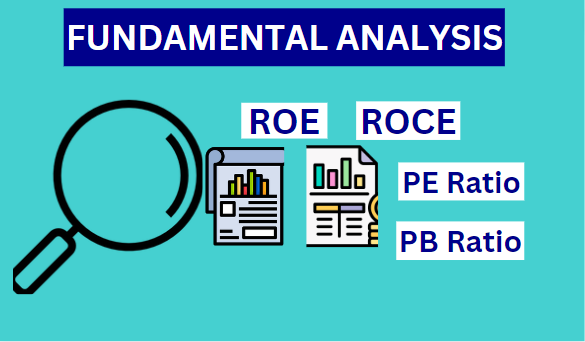In the world of investing, knowledge is power. Successful investors know the value of analysing stocks carefully before making decisions. With over 2000 stocks available for investment on the NSE, it’s vital to understand the companies you choose to invest in. This is where fundamental analysis comes in. In this blog, we’ll explore the concept of what is fundamental analysis and how it guides investors in making informed decisions.
“Investing without research is like playing poker without looking at the cards.” – Peter Lynch
List of contents
- What is fundamental analysis?
- Types of fundamental analysis
- Intrinsic value
- Advantage
- Disadvantage
- Conclusion
Read also: What is technical analysis?
What is fundamental analysis?
It is a way for investors to assess the real worth of a company or stock. It involves studying factors like financial statements, industry trends, economic indicators, and management quality. By understanding these fundamentals, investors can decide if a stock is overpriced or underpriced, allowing them to make informed investment choices.
It provides insights into a company’s present financial health and helps evaluate its long-term potential. Additionally, it also helps you determine a stock’s fair market value.
Types of fundamental analysis
There are two primary types: Quantitative analysis and Qualitative analysis
- Qualitative analysis: Qualitative analysis considers non-financial factors that affect a company’s or stock’s value. It examines things like management quality, competitive advantages, industry trends, and brand reputation. It also assesses how the management’s decisions impact the market and overall company performance. By considering these qualitative factors, investors can gain insight into the company’s potential for success.
- Quantitative analysis: it provides information through numbers and ratios. It involves studying the financial statements of the company (balance sheet, income statement, and cash flow statement) and financial ratios that show the financial health and profitability of the company. Key financial ratios are the price to earnings ratio (PE ratio), debt to equity ratio, return on equity (ROE), return on capital employed (ROCE), return on assets, price to book ratio (PB ratio), etc.
By examining these statements and calculating financial ratios, we can gain insights into the company’s financial situation and how well it is performing.
Intrinsic value
The intrinsic value of a stock refers to the estimated true worth of that stock based on its underlying fundamentals. By comparing the intrinsic value to the current market price of a stock, investors can determine whether the stock is overvalued, undervalued, or fairly priced.
If the intrinsic value is higher than the market price, the stock may be considered undervalued and potentially a good investment opportunity.
If the intrinsic value is lower than the market price, the stock may be overvalued, so avoid buying it.
Undervalued = intrinsic value > market price; result = buy.
Overvalued = intrinsic value < market price; result = avoid buying
Advantage
- Finding True Value: It helps investors determine the real worth of a company or stock, revealing if it is overvalued or undervalued. By investing in stocks that are trading below their intrinsic value, investors can potentially earn substantial returns when the market acknowledges their actual worth.
- Long-Term Perspective: It focuses on long-term potential investment opportunities instead of short-term market fluctuations.
- Informed Decision-Making: By analysing financial statements and industry factors, investors gain knowledge to make informed investment choices.
- Risk Management: It provides insights into a company’s financial stability, debt levels, and overall risk profile. By evaluating these factors, investors can assess the potential risks associated with investing in a particular stock, helping them make more informed risk-reward decisions.
- Long-Term Profitability: By identifying companies with strong financials and growth prospects, fundamental analysis can lead to long-term profitability.
Disadvantage
- Time and Effort: Conducting a thorough fundamental analysis requires significant time, effort, and expertise.
- Subjectivity: It involves interpreting data and making judgements. This introduces subjectivity, as different analysts may have varying interpretations and opinions on the same information, leading to potential biases.
- Uncertainty and External Factors: It may not fully account for unpredictable events or external factors that can significantly impact a company’s performance, such as regulatory changes, geopolitical events, or natural disasters. These unforeseen circumstances can affect the accuracy and reliability of the analysis.
To open zerodha account :- Click here
Read also: What is swing trading?
Conclusion
We have learned about ‘what is fundamental analysis’ in this blog. It is essential in investing as it helps evaluate the real worth of companies and stocks. It provides insights into their financial health and growth potential, enabling investors to spot undervalued or overvalued assets. With a long-term perspective, it emphasises the underlying fundamentals rather than short-term market changes
Happy trading!
I hope you enjoyed reading this. Please share it with other and do comment!
Read also: What is IPO?

